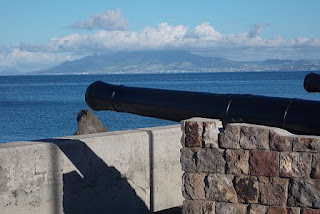 |
| Palm Tree Alley lined with cottages at Nisbet Plantation on the island of Nevis (Taylor) |
NEVIS, November 28, 2015 – When winter
looms, the Caribbean beckons and Nisbet Plantation on the island of Nevis
Nisbet
Plantation is a place where Valium goes to relax.
 |
| Nisbet's remnants of its former sugar industry (Taylor) |
“On
the island time forgot is a hotel you will remember forever,” is the way the Caribbean ’s only historic plantation on the beach
describes itself.
If
first impressions are lasting ones, then visitors are immediately drawn to
Nisbet Plantation’s signature gateway to the Caribbean Sea
known as “Palm Tree Alley.” The 30-acre
tropical beachfront property uniquely combines a storied history with casual
elegance.
Once
immersed in the contagious ambiance of Nevis ,
visitors soon wonder what all the fuss was about back home. Nevis’ sister
island of St. Kitts,just two miles across the
shallow channel called “The Narrows,” seems like Mardi Gras by comparison.
 |
| Quiet street in downtown Charlestown (Taylor) |
On
Nevis the biggest event of the day will likely be a dominoes match between some
of the locals in the capital city of Charlestown
Meanwhile,
at Nisbet Plantation, the toughest decision a guest may make all day is which
rope hammock to choose at the beach.
 |
| Clouds are common around Nevis Peak (neviscycleclub.com) |
Interlaced
within its tranquil setting, Nisbet’s history hearkens to the romantic past of
a more genteel era. Nevis is a gumdrop shaped
island encompassing just 36-square miles. In the center rises Nevis Peak
Little
wonder that the island’s 18th century plantation life embraced a
legacy of cultured gentility, an ambiance that lives on at Nisbet Plantation.
Remnants
of the sugar cane industry that once made Nevis “Queen of the Caribees” can be
found everywhere on the island, and Nisbet Plantation was one of the richest.
When Admiral Lord Nelson, the famed British naval hero, visited Nevis , he met Frances Nisbet, the wealthy widowed wife of
Dr. Nisbet, who owned the plantation.
 |
| Fanny Nisbet, wife of Lord Nelson (wikipedia) |
Fanny,
as she was affectionately known, fell in love with the captain and they were
married at Saint John Figtree Parish Anglican Church in 1787.
Just
32-years earlier, in 1755, Alexander Hamilton, was born on Nevis .
Hamilton spent much of his childhood there
before becoming a founding father of the United States Hamilton
Christopher
Columbus sighted Nevis in 1493 calling it “Our Lady of the Snows,” a reference
to the perpetual cloud surrounding Nevis
Peak
More
than a century later, in 1607, Captain John Smith visited Nevis during the
voyage that eventually led to the founding of Jamestown ,
the first permanent English settlement in the New World .
Electricity
came to Nevis in 1954, but it was not
available throughout the island until 1971. Even today, one will not see
traffic lights or buildings constructed taller than a coconut palm tree.
 |
| Avenue of the Palms or Palm Tree Alley -- either way the Caribbean beckons (Taylor) |
For
travelers enjoying Nisbet Plantation, Nevis ’ history
whets the appetite for island exploration and quiet dinner conversation. Dinner
is served in the Great House, while breakfast and lunch are available on the
beach where the Avenue of Palms gently yields to the embrace of the Caribbean Sea .
In
1950, Mary Pomeroy purchased the property and attempted, without success, to
turn it into a coconut plantation. Eventually Pomeroy refurbished some guest
rooms and later added bungalow-style cottages leading down to the beach.
 |
| Typical Nisbet Plantation cottage (Taylor) |
Nisbet
Plantation features 36 rooms, of which 14 are superior rooms and 22 are suites
in three categories. All rooms are elegantly appointed regional motifs and soft
Caribbean pastels.
Rates,
which include full a breakfast and dinner, as well as afternoon tea, vary
according to season. Among the amenities are free Wi-Fi and 110-volt electrical
current sockets, the same as the United States
Resort
facilities include a spa, tennis, fitness center and croquet lawn, plus three
restaurants.
A
favorite gathering spot is the great house which faces the rows of palm trees
that lure guests to the beach. The Tea Patio overlooking Palm
 |
| Nisbet's Great House greets guests (Taylor) |
Perhaps more than anything the subtle touches give Nisbet Plantation its charm. Guests are greeted by name when they arrive for breakfast. Forget television. No HDTV here. Nisbet compensates with a small 6 page newspaper of its own that provides all the news of the day. For junkies who just cannot break away, the wi-fi offers access to the outside world. Tree Alley is
especially enticing in late afternoon when the day eases into the amber glow of
twilight and sea breezes waft through the palms.
 |
| Rare view of Nevis Peak when it is not surrounded by cloud at its summit (Taylor) |
On
the tiny hump-shaped paradise of Nevis , Nisbet
Plantation is one of the few properties with direct access to the beach --
reason enough to saunter down Palm Tree Alley to locate that perfect hammock
for the serenity that awaits.
 |
| The Great House nestles at the end of Palm Tree Alley at Nisbet Plantation (Taylor |
If
Nevis is the “place that time forgot,” then it
is also a place to forget about time.
Originally published in Communities Digital News
For more travel stories and exciting tours go to: Magellan Travel Club













































